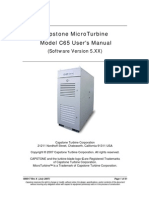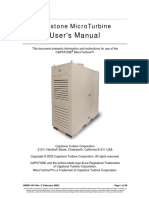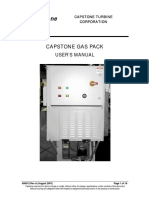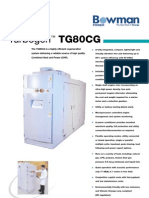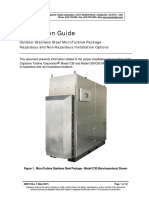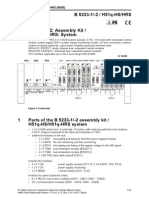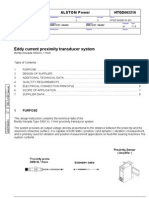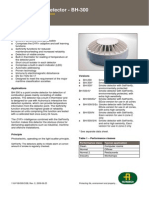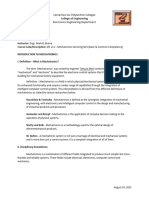C65 Ichp
C65 Ichp
Uploaded by
Joanna LockCopyright:
Available Formats
C65 Ichp
C65 Ichp
Uploaded by
Joanna LockOriginal Description:
Original Title
Copyright
Available Formats
Share this document
Did you find this document useful?
Is this content inappropriate?
Copyright:
Available Formats
C65 Ichp
C65 Ichp
Uploaded by
Joanna LockCopyright:
Available Formats
480014 Rev A (February 2006) Page 1 of 22
Capstone reserves the right to change or modify without notice, the design, the equipment ratings, and/or the contents of this
document without incurring any obligation either with respect to equipment previously sold or in the process of construction.
Capstone
Capstone Turbine Corporation 21211 Nordhoff Street Chatsworth CA 91311 USA
Telephone: (818) 734-5300 Facsimile: (818) 734-5320 Website: www.microturbine.com
Appl i c at i on Gui de -
Model C65 I nt egrat ed CHP (I CHP)
This document presents application information for the Capstone C65 MicroTurbine with the
Integrated CHP (ICHP) heat recovery module option.
Introduction
Capstone MicroTurbines are prime power generators, producing high quality, commercial-
grade electric power. The C65 ICHP System offers an energy dense, small footprint, with
clean exhaust and co-generation capabilities with complete control at the customers
fingertips. These characteristics allow for low installed cost, quick start-up and low
maintenance costs.
MicroTurbines can be used to produce power in parallel with a power grid (Grid Connect), to
work as a Stand Alone generator, or to provide Dual Mode functionality. Due to this
versatility, Capstones C65 ICHP Systems can be applied in a variety of applications, and
multiple units can be controlled as a MultiPac. They are currently used to provide continuous
power to hotels, grocery stores, oil-field processing equipment, schools and office buildings,
reliable off-grid power to data centers, telecom equipment and protected manufacturing
processes.
This document describes the application of MicroTurbines and external equipment in a
variety of power applications.
Table of Contents
Introduction.......................................................................................................... 1
Summary.............................................................................................................. 2
Modes of Operation.............................................................................................. 3
Heat Exchanger Water Connections.................................................................... 9
Water Specifications............................................................................................. 9
Thermal Performance Curves ............................................................................ 11
Water System Curves ........................................................................................ 16
Exhaust Ducting Requirements.......................................................................... 17
Application Examples......................................................................................... 19
Boiler Feedwater Preheat......................................................................................................19
Use of Intermediate Heat Exchanger....................................................................................20
Absorption Chiller...................................................................................................................21
Related Documentation...................................................................................... 22
Capstone Technical Information......................................................................... 22
Capstone Turbine Corporation 21211 Nordhoff Street Chatsworth CA 91311 USA
Application Guide: Model C65 Integrated CHP
480014 Rev A (February 2006) Page 2 of 22
Capstone reserves the right to change or modify without notice, the design, the equipment ratings, and/or the contents of this
document without incurring any obligation either with respect to equipment previously sold or in the process of construction.
Summary
The C65 Integrated CHP System (C65 ICHP) is an integrated single package that includes a
high-pressure natural gas C65 MicroTurbine with a hot water heat exchanger mounted on the
top. The C65 ICHP system is available in Grid Connect or Dual Mode versions, and includes
an exhaust diverter and factory-installed modem.
The hot water thermal output depends on the position of the diverter (full heat recovery, full
bypass, or any intermediate position), the temperature and flow of the exhaust gas from the
MicroTurbine, and the inlet water temperature and water flow. The exhaust temperature and
flow of the MicroTurbine depend on the ambient temperature, elevation above sea level, and
electric power output. There is a minimum heat transfer to the hot water heat exchanger of
about 10,000 BTU/hr (3kWt), regardless of diverter position and electric power output. This is
due to a combination of conducted heat from the exhaust ducting and small amounts of
exhaust leakage into the heat exchanger core. This requires continuous water flow
whenever the microturbine is operating.
The nominal rated output at full heat recovery is 380,000 BTU/hr (112kWt) of hot water with
the MicroTurbine operating at full 65kW electrical power output under ISO conditions, inlet
water temperature of 140F (60C), and water flow of 40 gpm (2.5 l/s).
The following table provides general guidelines for how each of these variables impact the
hot water thermal output:
Table 1. Thermal Output Variables
Variable Change in
Variable
Change in Thermal Output
Engine Power Output Increase Increase
Ambient Temperature Increase Increase (assuming constant power)
Hot Water Inlet Temp Decrease Increase
Water Flow Rate Increase Increase
Elevation Increase No Change (assuming constant power)
Detailed performance data is provided in the Thermal Performance Curves section below.
The C65 ICHP System provides flexibility to operate in several thermal and electrical modes,
accepts analog and discrete control inputs, and provides discrete output signals. The
MicroTurbines integral microprocessor control system reads and displays inlet and outlet
water temperatures, and adjusts thermal or electrical output based on these measured
temperatures or external analog control signals. The user can set modes of operation and
read selected thermal information from the front panel or remotely using Capstone Remote
Monitoring (CRMS) Software.
The system is UL listed to 2200 and 1741, and meets IEEE 519. The heat recovery system
incorporates several safety features to prevent equipment damage, including an integral high
temperature switch to shut down the MicroTurbine if heat exchanger core temperatures
become too high, and a pressure relief valve to protect the core from excessive pressures. In
addition, the integral control system performs several self-checks during startup, and
monitors current draw from the diverter actuator to confirm proper operation.
Capstone Turbine Corporation 21211 Nordhoff Street Chatsworth CA 91311 USA
Application Guide: Model C65 Integrated CHP
480014 Rev A (February 2006) Page 3 of 22
Capstone reserves the right to change or modify without notice, the design, the equipment ratings, and/or the contents of this
document without incurring any obligation either with respect to equipment previously sold or in the process of construction.
Modes of Operation
There are three basic thermal operating (CHP) modes, as summarized in the table below:
Table 2. CHP Operating Modes
CHP
Mode G
r
i
d
C
o
n
n
e
c
t
S
t
a
n
d
A
l
o
n
e
Description
Thermal
Priority
X
The diverter is locked in the full heat recovery position. Electric power
is automatically adjusted to control thermal output using measured
water inlet, outlet or external temperature control signal. Temperature
setpoint and feedback are controlled by the Master. This mode cannot
be used in Stand Alone mode. If a Dual Mode unit has been set up to
operate in Thermal Priority mode, it will automatically switch to Electric
Priority mode when switched to Stand Alone operation, and switch
back to Thermal Priority in Grid Connect mode.
Electric
Priority
(with
Thermal
Tracking)
X X
In Grid Connect mode, electric power is controlled either as a fixed
setpoint or using one of several electric load following schemes. In
Stand Alone mode, the electric output is controlled by the connected
load. The diverter is automatically adjusted to try to maintain the
measured water inlet, outlet or external temperature control signal.
Maximum available heat recovery will depend on the electric output.
Thermal
Bypass X X
The diverter is locked in the full bypass position. A minimum amount
of heat will still be recovered, but will not depend strongly on the
electric power level. This is the default mode.
The most stable thermal tracking is achieved when the unit is grid connected and operating in
the Thermal Priority mode. This method also keeps thermal and electric outputs in
proportion, thereby preserving a high total system efficiency. This may be important if
specific overall system efficiencies must be maintained.
If electric output has higher value than thermal output, Electric Priority may be the best
operating mode. When the electric power output is fixed in Grid Connect operation, the
exhaust diverter will provide stable thermal tracking and will move to a stationary intermediate
position when thermal loads are constant.
When the MicroTurbine is set to electrically load follow in Grid Connect mode, or when
operating in Stand Alone mode, it may be forced to make constant electric power output
adjustments as loads change. This will result in the exhaust diverter constantly adjusting its
position to try to maintain the programmed thermal output. Therefore, when operating in
Electric Priority mode under these load changing conditions, thermal output control may not
be as stable as when set for a fixed electric output in Grid Connect mode. The system also
may not be able to provide the expected thermal output, since electric power will be
determined by load changes.
Capstone Turbine Corporation 21211 Nordhoff Street Chatsworth CA 91311 USA
Application Guide: Model C65 Integrated CHP
480014 Rev A (February 2006) Page 4 of 22
Capstone reserves the right to change or modify without notice, the design, the equipment ratings, and/or the contents of this
document without incurring any obligation either with respect to equipment previously sold or in the process of construction.
Another application consideration for operation in Stand Alone mode is the need for the water
flow to be maintained. This may require that a pump or other flow controls be powered by the
turbine output power.
Several C65 ICHP systems can be tied together using the Capstone MultiPac Cable Kits,
allowing information to be shared between systems. The CHP modes and electric MultiPac
operating modes are set independently, which provides application flexibility. However, not
all possible combinations can be used. When a system is set to operate in Thermal Priority
CHP Mode, it requires that the Master define the electrical output for the entire MultiPac
group. Therefore, the thermal requirement will be measured, and setpoint tracking done, only
by the Master. When MultiPac operation is enabled for a group that has been set to operate
in Thermal Priority CHP Mode, the Local C65 ICHP systems are automatically programmed
to reference the Masters temperature measurement and setpoint. If this is a Dual Mode unit,
the same Master temperature measurement and Master setpoint will be used in Stand Alone
mode. The table below summarizes how the systems are allowed to operate under different
MultiPac scenarios. First choose the desired CHP Mode for grid connect operation - the
corresponding CHP Mode for Stand Alone operation is then given in the table.
In the case that the MultiPac is disabled, it is still possible to read and set parameters for each
system in the group using CRMS software, provided they are communicating through the
MultiPac communications cable and the PC with CRMS software is connected to unit #1.
The two examples below illustrate different applications where the C65 ICHP Systems are
MultiPac-enabled with one Master and two Local units:
Example 1 presents an instance where two separate applications using the same MultiPac
output power require the same temperature setpoint but unique feedback sources.
Mode: Electrical Priority (Grid Connect or Stand Alone operation)
Settings: CHP Setpoint source Master
CHP Feedback source Local
Scenario: Master controls water temperature setpoint for the entire MultiPac, but
each C65 ICHP uses its own temperature feedback source. Note that each C65
ICHP System can be set to use its own inlet RTD, outlet RTD, or an external
temperature sensor for its temperature feedback source.
Grid Connect Operation Stand Alone Operation Unit Type
CHP Mode
Temperature
Measurements
and Setpoints
CHP Mode
Temperature
Measurements
and Setpoints
Thermal Priority Master Only
Grid Connect
65C-HG4-XXXX
Electric Priority with
Thermal Tracking
Master or Local
Thermal Priority Master Only
Electric Priority with
Thermal Tracking
Master Only
Dual Mode
65C-HD4-XXXX
Electric Priority with
Thermal Tracking
Master or Local
Electric Priority with
Thermal Tracking
Master or Local
MultiPac Operating Modes (MultiPac Enabled)
Capstone Turbine Corporation 21211 Nordhoff Street Chatsworth CA 91311 USA
Application Guide: Model C65 Integrated CHP
480014 Rev A (February 2006) Page 5 of 22
Capstone reserves the right to change or modify without notice, the design, the equipment ratings, and/or the contents of this
document without incurring any obligation either with respect to equipment previously sold or in the process of construction.
Example 2 presents an instance where three separate applications using the same MultiPac
output power require unique temperature setpoints and temperature feedback sources.
Mode: Electrical Priority (Grid Connect or Stand Alone operation)
Settings: CHP Setpoint source Local
CHP Feedback source Local
Scenario: Each C65 ICHP System uses its own temperature feedback source and
temperature setpoint to control the output water temperature. Note that each C65
ICHP System can be set to use its own inlet RTD, outlet RTD, or an external
temperature sensor for its temperature feedback source.
MultiPac
Electrical Load
Connection
80 F
70 F
95 F
#1 #2
#3
Thermal
Appl. 1
Thermal
Appl. 2
Thermal
Appl. 3
The C60/C65 Integrated CHP System Technical Reference (410043) provides additional
details on how to set up the C65 ICHP Systems to enable each of these MultiPac modes.
Three
C65 ICHP Systems
in MultiPac
Three
C65 ICHP Systems
in MultiPac
MultiPac
Electrical Load
Connection
75 F 75 F 75 F
#1 #2 #3
Thermal
Application 1
Thermal
Application 2
Local Temperature
Feedback
Sources
Setpoint for
Systems #2 & 3
Controlled by #1
Local Temperature
Feedback
Sources
Setpoints
Controlled by Each
System
Capstone Turbine Corporation 21211 Nordhoff Street Chatsworth CA 91311 USA
Application Guide: Model C65 Integrated CHP
480014 Rev A (February 2006) Page 6 of 22
Capstone reserves the right to change or modify without notice, the design, the equipment ratings, and/or the contents of this
document without incurring any obligation either with respect to equipment previously sold or in the process of construction.
WARNING
Excessive water temperatures may result in personal injury and/or equipment
damage. Follow good engineering practice in the design and installation of
any hot water circuit, and consider the unique operating characteristics of the
Capstone C65 Integrated CHP System as noted below.
The C65 ICHP System is designed to protect itself from excessive temperatures and
pressures. However, it is the responsibility of the person(s) designing and installing the
system to assure that resulting temperatures and pressures do not cause a safety hazard or
damage other equipment. Several points should always be considered:
1. As a general precaution, the Over Temperature limits for each C65 ICHP System should
be set to cause shutdown of the system when outlet water temperatures go above the
safety and/or equipment damage levels for the specific application. Refer to the
C60/C65 ICHP System Technical Reference (410043) for setting these Over
Temperature limits.
2. Temperatures should be monitored at points in the water circuit where excessive
temperature may cause a safety hazard or damage equipment. Consideration should
be given to automatically adjust power output, or even shut down the associated C65
ICHP Systems, if safe operating limits are exceeded.
3. For any MultiPac application where the Master is providing the temperature feedback
signal, care should be taken to assure that this temperature signal is proper for the hot
water output of all other C65 ICHP systems that are MultiPac-enabled under all possible
operating scenarios. For example, if the water circuit for one of the Local C65 ICHP
Systems is different than the water circuit for the Master, temperature feedback signals
from the Master could result in continued heat addition from the Local C65 ICHP System
that could result in safety and/or equipment damage issues. For water circuits that have
taken this into account during normal intended operation, the potential for a water circuit
to be inadvertently put into an unsafe condition must be considered (such as from valve
and/or water pump failure or manual adjustment of valves or pumps).
4. For any MultiPac application where the Master is providing either the temperature
feedback signal or the temperature setpoint for the entire MultiPac, the consequences of
failure of the Master must be considered. The Capstone MultiPac logic is set up to
control operation of the Local C65 ICHP units. Note that in Electric Priority mode, the
Local C65 ICHP units will continue to provide hot water output at the last setpoint issued
from the Master, which may provide more hot water than required. Means to avoid this
situation must be included in the total system control scheme, such as by interlocking
the Master with the Local units to cause them to shut down in the case of a failure of the
Master.
The following table describes the impact on Local MultiPac-enabled units if the MultiPac
Master fails:
CHP Mode GC SA Impact on Local MultiPac-enabled Units if Master Fails
Thermal Priority X Local units will shut down
Electric Priority X X
Local units will continue operating at the last commanded
setpoint
Thermal Bypass X X Local units will continue operating
Capstone Turbine Corporation 21211 Nordhoff Street Chatsworth CA 91311 USA
Application Guide: Model C65 Integrated CHP
480014 Rev A (February 2006) Page 7 of 22
Capstone reserves the right to change or modify without notice, the design, the equipment ratings, and/or the contents of this
document without incurring any obligation either with respect to equipment previously sold or in the process of construction.
Major System Components
Figure 1 shows the major elements in the C65 ICHP system heat recovery module. The
MicroTurbine components provide the same functionality and control as the standard
Capstone C65 high pressure natural gas system. The CHP system adds the following major
elements:
1. Gas to Water Heat Exchanger An efficient heat exchanger core is provided to extract
energy from the MicroTurbine exhaust. It uses counter flow of exhaust and water to
provide the maximum heat transfer. Standard construction is copper tubes with copper
fins on the exhaust gas side. An all stainless steel construction is available as an option.
2. Exhaust Gas Diverter An exhaust gas diverter plate controls the amount of waste
exhaust heat that passes through the heat exchanger. In the bypass position, nearly all
of the MicroTurbines exhaust is directed straight out, avoiding contact with the heat
exchanger. Only a small amount (approximately 10,000 BTU/hr, or 3kWt) of the
MicroTurbines waste heat is transmitted into the water in the heat exchanger through
conduction in the heat exchanger assembly and convection due to small amounts of
exhaust leakage past the diverter. When moved to the full heat recovery position, the
diverter forces most of the MicroTurbine exhaust through the heat exchanger. The
diverter is also able to operate at intermediate positions, allowing part of the exhaust to
flow across the heat exchanger. The diverter is driven by a linear actuator, which is
controlled by the internal system logic and can modulate to provide Thermal Tracking
independently of electric power output.
3. Linear Actuator The linear actuator controls the diverter position, and receives its input
command from the CHP Control Board. The actuator is rated for the high temperatures it
may encounter near the heat exchanger and exhaust ducting.
4. CHP Control Board Most of the CHP system inputs and outputs are monitored and
controlled with the CHP control board assembly. This control board is an intelligent I/O
module able to convert analog signals to digital values and communicate them to the
MicroTurbines main CPU using the Capstone internal RS 485 communications bus. It is
also a power supply for the linear actuator, providing the current to drive the diverter
between bypass and recovery positions.
5. Water Temperature Sensors Resistive thermal device (RTD) sensors are mounted to
the water inlet and outlet connections of the heat exchanger, and are read by the CHP
Control Board. These measured water temperatures can also be read from the C65
MicroTurbine display.
6. Flow Switch A water flow switch is provided on the heat exchanger outlet to confirm
proper system operation. Its contact output is wired into the CHP Control Board. The
flow switch will close its contacts to indicate water flow above about 1.3 l/s (20 gpm). If
no flow is detected (flow switch contact open), the CHP Control Board will signal a fault
condition, and the C65 MicroTurbine will shut down to prevent or limit over temperature
damage to the heat exchanger core.
7. Safety Relief Valve A pressure relief valve set for 125 psi is installed at the water outlet
to prevent damage to the heat exchanger core due to unexpected high pressure.
WARNING
Excessive water temperatures may result in personal injury and/or equipment
damage. Pipe the relief valve outlet to a suitable location.
Capstone Turbine Corporation 21211 Nordhoff Street Chatsworth CA 91311 USA
Application Guide: Model C65 Integrated CHP
480014 Rev A (February 2006) Page 8 of 22
Capstone reserves the right to change or modify without notice, the design, the equipment ratings, and/or the contents of this
document without incurring any obligation either with respect to equipment previously sold or in the process of construction.
8. Thermostat The system may also include a thermally activated switch to indicate over
temperature of the heat exchanger core. If the temperature limit is reached, the switch
contact will open, causing the CHP Control Board to signal a fault condition and shut
down the MicroTurbine.
9. Optional Shutoff Valve and Pressure Sensor (External) The CHP Control Board will
accept a digital input from a pressure switch, and provide a 0.5A, 24Vdc output signal to
control a shutoff valve. The terminals on the CHP Control Board have a jumper installed
at the factory. Opening this jumper connection will cause a fault condition and shut down
the MicroTurbine. To use the external pressure switch input, the jumper must be
removed and pressure switch wired as a normally closed contact.
10. UCB Analog Inputs (not shown) Terminal J 14 in the UCB provides for analog control
and measurement inputs. Three 0 to 5Vdc (4 to 20mA) inputs are provided. These can
be defined during commissioning to represent electric power output control, external
water temperature measurement (for thermal control), and water flow measurement.
11. UCB Control Output (not shown) One of the six UCB digital output relay contacts can
be used as control output for turning a water pump on and off. The 5Vdc output becomes
active at lightoff (exhaust gas detected), and inactive at shutdown (no exhaust gas
detected). This output will become inactive immediately in case of an E-stop command to
the system.
12. Heat Recovery Unit Drain (not shown) A drain connection is provided to allow excess
moisture from condensation during start/stop sequences or small water leaks in the heat
exchanger core or associated connections. The drain is capable of water flow rates of
0.13 l/s (2 gpm), and should be piped to a suitable building drain location.
NOTE: Refer to C60/C65 Integrated CHP System Technical Reference (410043) for details.
Figure 1 - Heat Recovery Module
Water Supply Inlet
Exhaust
out
Water Inlet Temp (RTD)
C
o
n
t
r
o
l
B
o
a
r
d
Intra Harness
(inside microturbine)
Linear Actuator (with
integral limit switches)
Thermostat
(overtemp =open)
Flow Switch
(no flow =open)
Heat exchanger
Exhaust
In
Water outlet Temp (RTD)
Water Supply Outlet
Optional Shutoff and
Pressure Sensor for
Potable Water
Diverter
Bypass
Control
Pressure Switch
(low pressure =open)
.5A
24Vdc
Safety Relief Valve
Capstone Turbine Corporation 21211 Nordhoff Street Chatsworth CA 91311 USA
Application Guide: Model C65 Integrated CHP
480014 Rev A (February 2006) Page 9 of 22
Capstone reserves the right to change or modify without notice, the design, the equipment ratings, and/or the contents of this
document without incurring any obligation either with respect to equipment previously sold or in the process of construction.
Heat Exchanger Water Connections
In general, connections should be made to the C65 Integrated CHP System according to
sound engineering practice and local building codes for hot water heaters. Galvanic isolation
is suggested to prevent premature erosion of the heat exchanger and associated connections
whenever any metals other than copper are part of the total water circuit (note that the heat
exchanger is not warranted against such electro-chemical attack). Typically, shutoff valves
would be added at the inlet and outlet to the heat recovery unit to facilitate maintenance. The
C65 ICHP system includes a safety relief valve that must be connected to a suitable water
drain. There is also a water drain for collecting condensation or water leaks from the heat
exchanger core. This drain should also be plumbed to a suitable building drain. Refer to the
Model C60/C65 Integrated CHP System Technical Reference (410043) for more details on
these thermal connections.
Water Specifications
The Capstone heat recovery module has been designed for operation with water and
water/glycol mix. Figure 2 shows the allowable water flow rates versus outlet water
temperature, and Table 3 provides water quality requirements for reliable system operation.
A water/glycol mix is also acceptable up to 50 percent glycol. It is strongly recommended that
no other fluids or water flow rates be used directly in the heat recovery module, as corrosion
or erosion may result which are not covered by Capstones standard warranty. A suitable
intermediate heat exchanger should be used to isolate the Capstone heat recovery module
from chlorinated swimming pool water, salt water, or any other fluid not meeting the
specification in Table 3.
Figure 2. Heat Recovery Module Water Flow Requirements
10
20
30
40
50
60
70
60 80 100 120 140 160 180 200 220
Outlet Water Temperature [F]
W
a
t
e
r
F
l
o
w
[
g
p
m
]
Allowable Water Flow Range
Capstone Turbine Corporation 21211 Nordhoff Street Chatsworth CA 91311 USA
Application Guide: Model C65 Integrated CHP
480014 Rev A (February 2006) Page 10 of 22
Capstone reserves the right to change or modify without notice, the design, the equipment ratings, and/or the contents of this
document without incurring any obligation either with respect to equipment previously sold or in the process of construction.
When using water/glycol mixtures, the application must consider the lower heat transfer and
higher pumping losses for the chosen fluid mix.
Keep in mind the ambient temperatures for each application. For water, the minimum
ambient temperature should not go below 1.7
C (35
F). There is no freeze protection in the
system, and therefore the heat recovery module and associated piping can be damaged if
proper application is not followed. Damage due to freezing is not covered in Capstones
standard warranty.
Table 3. Water Quality Requirements
Item Limits
pH (25C) 6.5 - 8.5
Electrical Conductivity (micS/cm) 800 or less
M Alkalinity (ppm) 100 or less
Chloride ion (mg Cl/l) 200 or less
Sulfuric acid (mg SO4/l) 200 or less
Total hardness (mg CaCO3/l) 200 or less
Total iron (mg Fe/l) 1.0 or less
Sulfur ion (mg S/l) not detected
Ammonium ion (mg NH/l) 1.0 or less
Silica in ion state (mg SiO/l) 50 or less
Capstone Turbine Corporation 21211 Nordhoff Street Chatsworth CA 91311 USA
Application Guide: Model C65 Integrated CHP
480014 Rev A (February 2006) Page 11 of 22
Capstone reserves the right to change or modify without notice, the design, the equipment ratings, and/or the contents of this
document without incurring any obligation either with respect to equipment previously sold or in the process of construction.
Thermal Performance Curves
Thermal power output depends on several factors:
Electric Power Output The higher the electric output, the more thermal energy available
in the exhaust gas.
Ambient Temperature For a given electric power output, higher ambient temperature
also results in higher available exhaust energy.
Water Inlet Temperature As the water inlet temperature to the heat recovery system is
lowered, more energy can be extracted from the MicroTurbine exhaust gas.
Water Flow Rate Within the allowable water flow rates, there is a small variation in
captured thermal energy due to changes in water flow rate. Lower flow rates mean
higher water outlet temperatures, and thus slightly less captured thermal energy.
Elevation Thermal output de-rating is roughly proportional to the electric power de-rating
at all ambient temperatures, since electric efficiency does not change significantly with
elevation.
Exhaust Backpressure Increasing backpressure due to exhaust ducting results in
electric power output loss, but minimal thermal output change.
The information in this section provides a means to calculate the expected thermal output to
within 10% under various conditions. While this 10% tolerance range for thermal output is
rather large, the total system efficiency will have less variation since lower electrical efficiency
means higher available exhaust energy, and vice versa. There is also a strong variation in
expected thermal output depending on ambient temperatures and electric power output.
Therefore, it is suggested that the thermal output be calculated as simply as possible for
estimating performance and making economic projections. A procedure for estimating the
electric and thermal output is given below. Table 4 at the end of this section summarizes the
required steps, and can be referred to as needed.
The starting point for estimating thermal output is to select the ambient temperature(s) at
which the system is expected to operate. The Capstone product specifications are based on
ISO conditions of 15C (59F) and sea level elevation, since this is the basis of electrical
rating for the MicroTurbine. However, the system may be most needed at other
temperatures. For example; for building heating an ambient of 35 to 40F may be most
meaningful, while for application with an absorption chiller a 95F ambient may be a better
basis for rating.
Figure 3 shows the electric and thermal output for a single C65 Integrated CHP system
operating at full power and sea level elevation with 140F (60C
)
inlet water temperature and
40 gpm (2.5 l/s) water flow.
For example, at 60F ambient, the predicted thermal output is 112kW. To convert to BTU/hr,
multiply by 3,413 BTU/kWh (i.e. 112kW 382,000 BTU/hr). At 40F ambient, the predicted
thermal output is 102kW (348,000 BTU/hr). At 90F, predicted thermal output is 115kW
(392,000 BTU/hr), and electric output is 57.2kW. Note that electric power output can also be
read from the appropriate table in the C65 Performance Technical Reference 410048.
Capstone Turbine Corporation 21211 Nordhoff Street Chatsworth CA 91311 USA
Application Guide: Model C65 Integrated CHP
480014 Rev A (February 2006) Page 12 of 22
Capstone reserves the right to change or modify without notice, the design, the equipment ratings, and/or the contents of this
document without incurring any obligation either with respect to equipment previously sold or in the process of construction.
Hot Water and Electric Output
full electric power with 60C (140F) inlet and 2.5 l/s (40 gpm) water flow
30
40
50
60
70
80
90
100
110
120
-10 0 10 20 30 40 50 60 70 80 90 100 110 120 130
Ambient [F]
not e: f luid char act er ist ics det er mine minimum oper at ing ambient
k
W
O
u
t
p
u
t
Net Electric Power
Hot Water Output
Figure 3 Electric and Thermal Output vs. Ambient Temperature at
Full Electric Power and Sea Level Elevation
Elevation above sea level has the effect of de-rating the maximum power output, both electric
and thermal. Elevation de-rating curves for electric power output are provided in the C65
Performance Technical Reference (410048) . For example, using the 90F example above
and elevation of 1,000 feet, the electrical output would be reduced to about 55kW. The
thermal output stays in proportion to the electric output, with a slight additional reduction for
elevation of .5% per 1,000 ft. For this example, the thermal output is calculated to be 110kW
(375,000 BTU/hr).
For ambient temperatures above 70F, the electric power output will be reduced about .25%
for each inch water column backpressure. Thermal output will not change significantly.
Since maximum allowable backpressure is only 5 inches water column (after the integrated
CHP heat recovery module), the maximum change in electric power output is only 1.25% for
ambient temperatures above 70F with no change in the thermal output. Therefore
correcting output values due to system backpressure may not provide significant
improvement in accuracy of the calculated outputs. If a correction for backpressure is
desired, the method described here can be used. For the 90F and 1,000 foot elevation
example above with 4 inch water column backpressure, the 55kW electric becomes 54.5kW.
The 110kW (375,000 BTU/hr) thermal output remains the same.
The thermal output at different inlet water temperatures is essentially a linear relationship, as
shown in Figure 4. The curve in Figure 3 is for 140F (60C) inlet temperature. Use Figure 4
to estimate the correction factor for other inlet water temperatures, or use the equation shown
Capstone Turbine Corporation 21211 Nordhoff Street Chatsworth CA 91311 USA
Application Guide: Model C65 Integrated CHP
480014 Rev A (February 2006) Page 13 of 22
Capstone reserves the right to change or modify without notice, the design, the equipment ratings, and/or the contents of this
document without incurring any obligation either with respect to equipment previously sold or in the process of construction.
in the figure. For example, if the inlet water temperature is 165F (74C), the correction factor
is .94, and thermal output would be 103kW (or 353,000BTU/hr).
kW (BTU/hr) Correcti on Factor vs Inl et Water Temp
0.85
0.90
0.95
1.00
1.05
1.10
1.15
80 100 120 140 160 180 200
Inlet Water Temperature [F]
C
o
r
r
e
c
t
i
o
n
F
a
c
t
o
r
Correction Factor vs Inlet Water Temp
Linear Approximation
=1-(Temp - 140)*.0023
Figure 4 Correction Factor for Thermal Output vs Inlet WaterTemperature
There is a small variation in the predicted thermal output depending on water flow rate.
Figure 5 shows this correction factor, and provides a curve fit equation as well. For example,
to convert the 40 gpm thermal output numbers above to thermal output at 30 gpm (1.3 l/s),
the correction factor is about .97 (or 3% lower than predicted for 40 gpm). Therefore, the
predicted thermal output at 90F ambient with 165F inlet water temperature and 30 gpm
water flow becomes 100kW (or 342,000 BTU/hr).
kW (BTU/hr) Correcti on Factor vs Water Fl ow Rate
0.92
0.94
0.96
0.98
1.00
1.02
1.04
1.06
20 30 40 50 60
Water Flow Rate [gpm]
C
o
r
r
e
c
t
i
o
n
F
a
c
t
o
r
Correction Factor vs Flow Rate
Curve Fit Approximation
=.83+.0056*(Flow)-3.4E-5*(Flow)
2
Figure 5 Correction Factor for Thermal Output vs Water Flow
Once the net thermal output has been calculated for the selected ambient temperature,
elevation, and inlet water temperatures (and corrected if needed for water flow rate), the
water outlet temperature can be easily calculated using the equation below. The specific
heat capacity and density of water are both relatively constant over the allowable temperature
range of 60 to 220F, and their product is within .7% using a 160F nominal inlet water
Capstone Turbine Corporation 21211 Nordhoff Street Chatsworth CA 91311 USA
Application Guide: Model C65 Integrated CHP
480014 Rev A (February 2006) Page 14 of 22
Capstone reserves the right to change or modify without notice, the design, the equipment ratings, and/or the contents of this
document without incurring any obligation either with respect to equipment previously sold or in the process of construction.
reference temperature. Therefore, the following simple equation is a highly accurate method
for estimating the temperature rise for any water-based heat recovery system when the
thermal output is known:
Thermal Output [kW]
Temperature Rise [F] =6.9 X
Water Flow [gpm]
Using the 90F ambient temperature example above for 1,000 foot elevation, 140F inlet
water temperature, and 40 gpm water flow, the thermal output of 110kW at 40 gpm water
flow provides a temperature rise of 19F. For the 165F inlet water temperature and 30 gpm
water flow, the thermal output of 100kW provides a temperature rise of 23F.
While the previous calculations have been based on the full power output from Figure 3, the
effect of partial load operation can also be estimated if necessary. The operating scheme for
the MicroTurbine is to try to maintain turbine outlet temperature by varying turbine speed (and
therefore exhaust mass flow) as power requirements change. If turbine efficiency remained
constant as power output decreased, a linear relationship for thermal output would follow; that
is, if the MicroTurbine were operating at half power, the thermal output would likewise be half
its full power output.
This is almost the case down to about 50% power output for the C65 MicroTurbine, so as a
first approximation simply ratio the thermal with the electric output. For less than 50% electric
power output, the ratio of thermal output to electrical output will increase. However, a
conservative thermal output can be estimated by using the same thermal to electric output
ratio for all power levels.
The above analysis is for water. The system can accept up to 50% water glycol mix, with
slight change in the captured heat and water temperature rise. As an example, a 30%
propylene glycol mix was analyzed for a 140F inlet temperature and 32 gpm water flow with
the following results (exhaust input energy constant):
Water 409,000 BTU/hr and temperature rise of 25.6F
30% Glycol 397,000 BTU/hr and temperature rise of 26.4F
Table 4 provides a guide process and example for calculating maximum thermal and electric
power output and associated water temperature rise for a given application.
Capstone Turbine Corporation 21211 Nordhoff Street Chatsworth CA 91311 USA
Application Guide: Model C65 Integrated CHP
480014 Rev A (February 2006) Page 15 of 22
Capstone reserves the right to change or modify without notice, the design, the equipment ratings, and/or the contents of this
document without incurring any obligation either with respect to equipment previously sold or in the process of construction.
Table 4. Electric and Thermal Output Calculations
Steps Rule Example*
1. Estimate maximum
electric and thermal output
for the given ambient
Temperature
Use Figure 3 and refer to
C65 Performance Technical
Reference (410048)
for 90F Ambient:
57.2kW electric
115kW thermal
2. Estimate electric and
thermal output at the given
Elevation
Electric output de-rated per
C65 Performance Technical
Reference (410048)
Thermal de-rating in proportion to
Electric de-rating, plus .5% per
1,000ft elevation
for 1,000ft Elevation:
55kW electric
110kW thermal
3. Determine Correction
Factor for Backpressure
Electric Output de-rated .25% per
inch WC above 70F ambient
for 4 inch WC:
CF =.99
4. Determine Correction
Factor for Inlet Water
Temperature
Use Figure 4 for 165F Inlet Water:
CF =.94
5. Determine Correction
Factor for Water Flow
Use Figure 5 for 30 gpm Water Flow:
CF =.97
6. Calculate Estimated
Electric and Thermal
Outputs
Electrical Output from Step 2
times Correction Factor in Step 3;
Thermal Output from Step 2
times Correction Factors in Steps
4 and 5
54.5kW electric
100kW thermal
7. Estimate Temperature
Rise for given Water Flow
Use equation: 6.9 times Thermal
Output [kW] divided by Water
Flow [gpm]
23F Rise
(188F Outlet Temp)
* 90F Ambient, 1,000 foot elevation , 4 inch WC backpressure, 165F inlet water, 30 gpm
Capstone Turbine Corporation 21211 Nordhoff Street Chatsworth CA 91311 USA
Application Guide: Model C65 Integrated CHP
480014 Rev A (February 2006) Page 16 of 22
Capstone reserves the right to change or modify without notice, the design, the equipment ratings, and/or the contents of this
document without incurring any obligation either with respect to equipment previously sold or in the process of construction.
Water System Curves
The C65 ICHP heat exchanger is designed for low water pressure drop. Figure 6 provides
the pressure drop, in feet of water head, versus water flow rate.
Figure 6 Heat Exchanger Water Pressure Drop
Choose a pump suitable for the total water system drop, including the heat exchanger,
associated piping, and any intermediate heat exchanger or other water circuit equipment.
Figure 7 provides an example of how to size a pump for a given water circuit. For the
example given, the selected pump will provide 52 gpm water flow.
Figure 7 Example System Curve
Water System Curve - C65 iCHP Heat Exchanger
0
5
10
15
20
25
10 20 30 40 50 60 70 80
Water Flow [gpm]
H
e
a
d
[
f
t
]
Water System Curve - iCHP with 2 in Cu Pipe
ref 1/2 Hp 1750rpm 1
1
/
2
X 2 X 6 pump (Gould or Bell & Gossett)
0
5
10
15
20
25
10 20 30 40 50 60 70 80
Water Flow [gpm]
H
e
a
d
[
f
t
]
C65 iCHP
Exchanger
Water Pump
Performance Curve
(4
3
/
8
inch impeller)
Total Water System
(including 100 ft pipe and
C65 iCHP Exchanger)
Resulting Flow
Capstone Turbine Corporation 21211 Nordhoff Street Chatsworth CA 91311 USA
Application Guide: Model C65 Integrated CHP
480014 Rev A (February 2006) Page 17 of 22
Capstone reserves the right to change or modify without notice, the design, the equipment ratings, and/or the contents of this
document without incurring any obligation either with respect to equipment previously sold or in the process of construction.
Exhaust Ducting Requirements
The C65 ICHP system package has been designed for indoor or outdoor application. An
outdoor exhaust flapper is included as standard, so for most outdoor applications no
additional exhaust ducting will be required. For indoor application, or outdoor applications
requiring duct extensions, suitable insulated exhaust ducting will be required.
Several factors must be considered when designing suitable exhaust ducting:
1. Backpressure Exhaust ducting must be pressure rated, and properly sealed to avoid
buildup of toxic exhaust fumes. The C65 ICHP systems MicroTurbine will provide
positive exhaust flow under normal operation. However, the exhaust system must limit
backpressure to no more than 5 inches of water column under all operating conditions.
Nominal exhaust flow rate at full power is 460 l/s or 965 standard cubic feet per minute
(scfm). This is roughly 1,850 cfm when adjusted for temperature. The exhaust outlet of
the C65 ICHP system is 10-inch diameter. Guidance for backpressure calculations is
available from ducting manufacturers. If the system design includes a backflow damper
(ref item 5 below), use 0.7 inches of water column as the estimated forward pressure
drop across the damper.
2. Temperature Rating At full power and without heat recovery, the nominal exhaust
temperature of the C65 ICHP is less than 600 F. However, during transient conditions
and/or high ambient temperature operation, the exhaust can reach 700 F. Therefore,
exhaust ducting must be rated for at least 700 F. In addition, sufficient thermal insulation
should be provided to avoid hazards to personnel or buildings due to contact with high
temperature exhaust ducting. As a reference, double wall stainless steel ducting with 2 to
4 inch ceramic fiber insulation is a general-purpose solution. However, specifics of the
application must be considered when designing a proper installation.
3. Condensation While the exhaust system needs to be capable of the maximum
temperature noted above, normal heat recovery operation reduces the exhaust
temperature considerably. Therefore, the potential for condensation of moisture in the
exhaust must be considered in any ducting system. For short runs to direct exhaust
outside (for example through a single story roof or to elevate slightly the point of exhaust
in an outdoor installation), and when the ICHP system is not switched on and off
frequently, it may not necessary to make any accommodation for condensation.
However for any other application, it is suggested that the exhaust ducting include means
to capture any condensation and direct it away from the top of the ICHP system exhaust.
Figure 8 shows a typical exhaust arrangement using an offset with drain.
4. Weight The C65 Integrated CHP System can accept a maximum load on the 10-inch
exhaust outlet of 25 lbs. When designing any exhaust ducting arrangement, suitable
supporting means must be included to avoid damage to the heat exchanger structure of
the C65 ICHP. Using an offset, as shown in Figure 8, is one way to avoid high loading.
Capstone Turbine Corporation 21211 Nordhoff Street Chatsworth CA 91311 USA
Application Guide: Model C65 Integrated CHP
480014 Rev A (February 2006) Page 18 of 22
Capstone reserves the right to change or modify without notice, the design, the equipment ratings, and/or the contents of this
document without incurring any obligation either with respect to equipment previously sold or in the process of construction.
5. Common Exhaust Ducting Exhaust from several MicroTurbines cannot be brought to a
common duct system without considering the impact of reverse exhaust flow. If one
MicroTurbine is not operating, exhaust from the common duct will flow back into the non-
operating unit. This condition will elevate temperatures in the non-operating unit, causing
potentially expensive equipment damage. If the non-operating unit is located indoors (or
other area with restricted ventilation), toxic exhaust fumes can build up, causing a safety
hazard for anyone in the area. Therefore, means to prevent backflow must be provided
for in the exhaust ducting system design. One method to avoid reverse flow is to add an
exhaust fan so that the common exhaust duct is always at negative gauge pressure.
High temperature induction type exhaust fans are suitable for the potentially high exhaust
temperatures, and must be interlocked with the MicroTurbines to assure that no
MicroTurbine is operating if the fan is not. An alternative is to use a suitable exhaust
backflow damper. Capstone offers backflow dampers with a maximum reverse flow of
0.1%, which are designed to prevent over-temperature damage to a non-operating
MicroTurbine. The total system design must still consider the impact that even this small
amount of reverse flow exhaust may have on any enclosed location. Currently, the
largest backflow damper offered by Capstone has an 8 inch diameter. The exhaust duct
can be reduced to 8 inches for the damper as well as downstream ducting, provided
exhaust pressure calculations are performed to ensure compliance with the maximum
allowable 5 inches water column backpressure at the C65 ICHP exhaust.
Exhaust Ducting
ICHP
Figure 8 Exhaust Ducting with Offset for Condensation
(Complete Ducting and Support Structure not shown)
Capstone Turbine Corporation 21211 Nordhoff Street Chatsworth CA 91311 USA
Application Guide: Model C65 Integrated CHP
480014 Rev A (February 2006) Page 19 of 22
Capstone reserves the right to change or modify without notice, the design, the equipment ratings, and/or the contents of this
document without incurring any obligation either with respect to equipment previously sold or in the process of construction.
Application Examples
This section presents several application examples.
Boiler Feedwater Preheat
The simplest application is to use the C65 ICHP system as a pre-heater for boiler feedwater
return. Figure 9 shows an example. One way to control this installation is to have the C65
ICHP track its inlet water temperature, with a setpoint slightly lower than the Boilers control
setpoint. When the building load requires heat, the C65 ICHP system will be the first system
to respond, with the boiler only turning on if the CHP system cannot supply sufficient heat.
Out In
Electrical Output
Water Circuit
Building
Thermal
Load
ICHP
Expansion
Tank
Boiler
Figure 9 Boiler Feedwater Preheat Application Example
Capstone Turbine Corporation 21211 Nordhoff Street Chatsworth CA 91311 USA
Application Guide: Model C65 Integrated CHP
480014 Rev A (February 2006) Page 20 of 22
Capstone reserves the right to change or modify without notice, the design, the equipment ratings, and/or the contents of this
document without incurring any obligation either with respect to equipment previously sold or in the process of construction.
Use of Intermediate Heat Exchanger
For applications where the building water circuit is not compatible with the C65 ICHP
systems copper heat exchanger material, an intermediate heat exchanger can be used to
isolate the two water circuits as shown in Figure 10. This example shows how temperature
can be controlled at an external point in this case at the inlet to the intermediate heat
exchanger.
Out In
Electrical Output
Water Circuit
Building
Thermal
Load
ICHP
Master
Expansion
Tank
T1
Analog Temperature Input
Intermediate
Heat
Exchanger
Figure 10. Intermediate Heat Exchanger Application Example
Capstone Turbine Corporation 21211 Nordhoff Street Chatsworth CA 91311 USA
Application Guide: Model C65 Integrated CHP
480014 Rev A (February 2006) Page 21 of 22
Capstone reserves the right to change or modify without notice, the design, the equipment ratings, and/or the contents of this
document without incurring any obligation either with respect to equipment previously sold or in the process of construction.
Absorption Chiller
Combining the C65 ICHP system with absorption chillers provides high efficiency cooling for
buildings or processes. The example in Figure 11 shows two C65 ICHP systems feeding
their hot water output to a single hot-water-fired chiller. In this example, the chiller provides a
4-20 mA (or 0 to 5Vdc) control signal or an external temperature sensor input to both C65
ICHP systems to regulate their thermal output. Each ICHP system will then adjust its
respective thermal output to try to match the control signal or external temperature setpoint.
In this way, the chiller is acting as the master to control thermal input to meet changing
building thermal load requirements. Note that means must be included in the water circuitry
to assure that the water flow in each C65 ICHP heat exchanger remains within the allowable
useable range shown in Figure 2 (in this example, separate pumps are used for each C65
ICHP System).
Out In Out In
Electrical Output
Water Circuit
Building
Thermal
Load
Pumps
ICHP ICHP
Expansion
Tank
Analog Temperature Control
Signal fromChiller
Absorption
Chiller
HW
Out
CW
In
CW
Out
HW
In
Figure 11. Absorption Chiller Application Example
Capstone Turbine Corporation 21211 Nordhoff Street Chatsworth CA 91311 USA
Application Guide: Model C65 Integrated CHP
480014Rev A (February 2006) Page 22 of 22
Capstone reserves the right to change or modify without notice, the design, the equipment ratings, and/or the contents of this
document without incurring any obligation either with respect to equipment previously sold or in the process of construction.
Related Documentation
The following table lists applicable Capstone documentation.
Document No. Document Title
400000 Capstone MicroTurbine Users Manual
410048 Capstone Model C65 Performance Technical Reference
410043 Capstone Model C60/C65 Integrated CHP System Technical Reference
460000 Capstone MicroTurbine Product Specification
Capstone Technical Information
If questions arise regarding ICHP operation for your Capstone MicroTurbine, please contact
Capstone Turbine Technical Support for assistance and information.
Capstone Technical Support
Toll Free Telephone: (877) 282-8966
Service Telephone: (818) 407-3600 Fax: (818) 734-1080
E-mail: service@capstoneturbine.com
Capstone Technical Support (Japan)
Service Telephone: (818) 407-3700 Fax: (818) 734-1080
E-mail: servicejapan@capstoneturbine.com
You might also like
- Troubleshoot and Error CodeDocument308 pagesTroubleshoot and Error CoderismayudhaNo ratings yet
- Capstone C200 Microturbine: Technical ReferenceDocument126 pagesCapstone C200 Microturbine: Technical ReferenceCarloNo ratings yet
- FLOWBUS EPA Series Technical DataDocument5 pagesFLOWBUS EPA Series Technical DataRahim100% (1)
- Capstone C60 440052 - Commissioning - Procedures - WIDocument10 pagesCapstone C60 440052 - Commissioning - Procedures - WIPaulNo ratings yet
- 400017A C65 Users Manual V5XXDocument61 pages400017A C65 Users Manual V5XXwhusada100% (1)
- Centurion Configurable Controller Installation and Operations ManualDocument44 pagesCenturion Configurable Controller Installation and Operations ManualAnonymous LfeGI2hMNo ratings yet
- t100 Operators ManualDocument94 pagest100 Operators ManualAntonio Muñoz TorresNo ratings yet
- Model C30 PerformanceDocument16 pagesModel C30 PerformanceJlAguirreNo ratings yet
- User'S Manual: Capstone MicroturbineDocument56 pagesUser'S Manual: Capstone MicroturbinemassimocalviNo ratings yet
- Capstone: Capstone C1000 Microturbine SystemsDocument154 pagesCapstone: Capstone C1000 Microturbine SystemsLuis CamargoNo ratings yet
- CM3061Document1 pageCM3061Joanna LockNo ratings yet
- Basics of Governing System: Drawings Are Not As Per ActualDocument25 pagesBasics of Governing System: Drawings Are Not As Per ActualAhemad100% (1)
- Wouter Witzel Corporate Brochure NewDocument11 pagesWouter Witzel Corporate Brochure NewMohamed RjebNo ratings yet
- RevA Modbus Translator Tech RefDocument53 pagesRevA Modbus Translator Tech RefVoicu StaneseNo ratings yet
- 410009f TR Electrical InstallationDocument31 pages410009f TR Electrical InstallationMaría MartinezNo ratings yet
- Product Catalog 2002Document3 pagesProduct Catalog 2002goochkrNo ratings yet
- 410066C C200 Tech RefDocument137 pages410066C C200 Tech RefMohd Äwiw Vießar AvondrahNo ratings yet
- Technical Reference: Stand Alone Operation - Capstone Model C30 and C60/C65Document22 pagesTechnical Reference: Stand Alone Operation - Capstone Model C30 and C60/C65meysamhemmatiNo ratings yet
- 30kW Capstone MicroturbineDocument2 pages30kW Capstone MicroturbineMal KukuraNo ratings yet
- C800S Low Pressure NatGas, ICHPDocument2 pagesC800S Low Pressure NatGas, ICHPTri WaskitaNo ratings yet
- 1.7 Capstone Jim Crouse EnglishDocument40 pages1.7 Capstone Jim Crouse EnglishJuan Carlos BeleñoNo ratings yet
- MCM3320 ServiceDocument297 pagesMCM3320 ServiceAlesandro Mackedanz MaronNo ratings yet
- 410040C Modbus Translator Tech RefDocument58 pages410040C Modbus Translator Tech Refjuanjose1000No ratings yet
- B WI C200-C1000 Non-Bolted Combustor Liner ReplacementDocument17 pagesB WI C200-C1000 Non-Bolted Combustor Liner ReplacementJefferson Mosquera PerezNo ratings yet
- Work Instructions: UCB Battery Replacement Capstone Model C200 Microturbine/C1000 Series Purpose and ScopeDocument10 pagesWork Instructions: UCB Battery Replacement Capstone Model C200 Microturbine/C1000 Series Purpose and ScopeJefferson Mosquera PerezNo ratings yet
- 400009A DMC Users ManualDocument21 pages400009A DMC Users ManualDmitriy TverezovskiyNo ratings yet
- 440342A C200-C1000 LCM GCM IGBT Phase Leg ReplacementDocument18 pages440342A C200-C1000 LCM GCM IGBT Phase Leg ReplacementJefferson Mosquera PerezNo ratings yet
- 400012A 2007-08 Capstone Gas Pack User's ManualDocument16 pages400012A 2007-08 Capstone Gas Pack User's ManualAndrey KazakNo ratings yet
- 400008C C200 MicroTurbine UMDocument61 pages400008C C200 MicroTurbine UMDmitriy TverezovskiyNo ratings yet
- 460045D C200 PSDocument16 pages460045D C200 PSVoicu StaneseNo ratings yet
- Centurion C5 Series M-View Touch Series: Operations ManualDocument50 pagesCenturion C5 Series M-View Touch Series: Operations Manualgerardo.serco19No ratings yet
- A WI C200-C1000 Bolted Combustor Liner ReplacementDocument13 pagesA WI C200-C1000 Bolted Combustor Liner ReplacementJefferson Mosquera PerezNo ratings yet
- 9 MCM3320 Modbus Register Map (Address Sorted) April2006 PDFDocument51 pages9 MCM3320 Modbus Register Map (Address Sorted) April2006 PDFJose Flavio GonçaloNo ratings yet
- 16811Document18 pages16811MIRIAMNo ratings yet
- Work Instructions: Main Battery Replacement Capstone Model C200 Microturbine /C1000 Series Purpose and ScopeDocument11 pagesWork Instructions: Main Battery Replacement Capstone Model C200 Microturbine /C1000 Series Purpose and ScopeJefferson Mosquera PerezNo ratings yet
- 7300G NJEX Manual 6-2010-FinalDocument130 pages7300G NJEX Manual 6-2010-FinalThuong NguyenNo ratings yet
- Work Instructions: GCM Igbt Replacement Capstone Model C200 Microturbine /C1000 Series Purpose and ScopeDocument11 pagesWork Instructions: GCM Igbt Replacement Capstone Model C200 Microturbine /C1000 Series Purpose and ScopeJefferson MosqueraNo ratings yet
- Work Instructions: Air Filter Replacement Capstone Model C200 Microturbine /C1000 Series Purpose and ScopeDocument11 pagesWork Instructions: Air Filter Replacement Capstone Model C200 Microturbine /C1000 Series Purpose and ScopeJefferson MosqueraNo ratings yet
- Work Instructions: LCM Igbt Replacement Capstone Model C200 Microturbine /C1000 Series Purpose and ScopeDocument9 pagesWork Instructions: LCM Igbt Replacement Capstone Model C200 Microturbine /C1000 Series Purpose and ScopeJefferson MosqueraNo ratings yet
- Technical Reference: Capstone Remote Monitoring System (User Edition)Document4 pagesTechnical Reference: Capstone Remote Monitoring System (User Edition)Thomas VanceNo ratings yet
- Work Instructions: Igniter Replacement Kit Capstone Model C200 Microturbine /C1000 Series Purpose and ScopeDocument8 pagesWork Instructions: Igniter Replacement Kit Capstone Model C200 Microturbine /C1000 Series Purpose and ScopeJefferson Mosquera PerezNo ratings yet
- 400023A Dual Mode System Controller (DMSC) - User's Manual 2008-10Document27 pages400023A Dual Mode System Controller (DMSC) - User's Manual 2008-10Andrey KazakNo ratings yet
- SP FLX SGT 50.v3Document2 pagesSP FLX SGT 50.v3sungkarsNo ratings yet
- Model C30 Electrical Tech RefDocument22 pagesModel C30 Electrical Tech RefIan SnowNo ratings yet
- Capston VVHPDocument37 pagesCapston VVHPsnj144No ratings yet
- Catalog of CHP TechnologiesDocument131 pagesCatalog of CHP TechnologiesHotib PerwiraNo ratings yet
- Micro Turbine Power Market Study PDFDocument20 pagesMicro Turbine Power Market Study PDFMal KukuraNo ratings yet
- Manual Microturbina GasDocument37 pagesManual Microturbina Gasjlcl1976No ratings yet
- 1.2 KW Green Turbine BrochureDocument10 pages1.2 KW Green Turbine BrochureUmar MajeedNo ratings yet
- Commissioning Procedures WIDocument10 pagesCommissioning Procedures WITara WilcoxNo ratings yet
- InteliSys NTC BaseBox Leaflet 2014-01 CPLEISBB PDFDocument4 pagesInteliSys NTC BaseBox Leaflet 2014-01 CPLEISBB PDFdo phuongNo ratings yet
- DOE New CapstoneDocument2 pagesDOE New Capstonescribd-dudeNo ratings yet
- Bowman Power Turbogen TG80CGDocument2 pagesBowman Power Turbogen TG80CGcrikalaoNo ratings yet
- Micro Turbine III PDRDocument64 pagesMicro Turbine III PDRPablo NopiensodesirloNo ratings yet
- Recommendations For Chloro-Alkali Manufacturing Facilties For The Production of ChlorineDocument22 pagesRecommendations For Chloro-Alkali Manufacturing Facilties For The Production of ChlorineDeputy Electrical Inspector NizamabadNo ratings yet
- PACSystems RX3i Max-On Hot Standby Redundancy Manual, GFK-2409Document144 pagesPACSystems RX3i Max-On Hot Standby Redundancy Manual, GFK-2409Eduardo Diaz100% (1)
- Event ResettingDocument13 pagesEvent ResettingGabriel Paco LunaNo ratings yet
- Application Guide: Outdoor Stainless Steel Microturbine Package - Hazardous and Non-Hazardous Installation OptionsDocument54 pagesApplication Guide: Outdoor Stainless Steel Microturbine Package - Hazardous and Non-Hazardous Installation OptionsxavearNo ratings yet
- Capstone Microturbine Fuel Requirements Technical Reference: Capstone Turbine Corporation Phone: (818) 734-5300Document18 pagesCapstone Microturbine Fuel Requirements Technical Reference: Capstone Turbine Corporation Phone: (818) 734-5300Jivko BonevNo ratings yet
- C200-High-NatGas 331042E Lowres PDFDocument2 pagesC200-High-NatGas 331042E Lowres PDFyjtcyjctyjNo ratings yet
- B 5233-1/-2 / H51q-HS/HRS (0605)Document14 pagesB 5233-1/-2 / H51q-HS/HRS (0605)mshahabahmadNo ratings yet
- Eddy 2Document8 pagesEddy 2mahetrpNo ratings yet
- Autronica Smoke DetectorDocument2 pagesAutronica Smoke DetectorbhavadasNo ratings yet
- Multipurpose Tug v1 4 SPDocument44 pagesMultipurpose Tug v1 4 SPJoanna LockNo ratings yet
- Chapter 3 2. Polytropic or Small Stage Efficiency: PurposeDocument3 pagesChapter 3 2. Polytropic or Small Stage Efficiency: PurposeJoanna LockNo ratings yet
- AY1415 FYP Available List 20140626Document25 pagesAY1415 FYP Available List 20140626Joanna LockNo ratings yet
- Nus Me Core Modules 20140220Document3 pagesNus Me Core Modules 20140220Joanna LockNo ratings yet
- 101C and 20-10C Sluice Gate Multi-PageDocument12 pages101C and 20-10C Sluice Gate Multi-PageWalterHuNo ratings yet
- Product Bulletin No.: TDS-03-11 Released Top Drive Drilling SystemDocument9 pagesProduct Bulletin No.: TDS-03-11 Released Top Drive Drilling SystemMiroslav SekulićNo ratings yet
- Design and Development of Weldinng RobotDocument13 pagesDesign and Development of Weldinng RobotÊswâr SîñghNo ratings yet
- Extend - Retract and Stop System of A Linear Actuator Hydraulic TrainerDocument10 pagesExtend - Retract and Stop System of A Linear Actuator Hydraulic Traineratma aNo ratings yet
- Sensing and ActuationDocument48 pagesSensing and ActuationSaddam Hussein BNo ratings yet
- FCS CatalogueDocument366 pagesFCS CatalogueMohamed AymanNo ratings yet
- ) Mets: Iqdilution BookDocument106 pages) Mets: Iqdilution BookDanilNo ratings yet
- 7010 Valvulas Neumatica SCHUBERT SALZER PDFDocument8 pages7010 Valvulas Neumatica SCHUBERT SALZER PDFAngelo Sanchez IafantiNo ratings yet
- Chopra 1996Document43 pagesChopra 1996DeekshithNo ratings yet
- Viraaj CatalogDocument10 pagesViraaj CatalogRahulNo ratings yet
- ME 6408 Course Outline Spring14Document13 pagesME 6408 Course Outline Spring14Mohamed IbrahimNo ratings yet
- Butterfly-Valves - (BV-BLKI - BV-BPLD) Soft Seated - ENDocument23 pagesButterfly-Valves - (BV-BLKI - BV-BPLD) Soft Seated - ENjavahz74No ratings yet
- (PDF) Assignment 1 - Introduction To MechatronicsDocument4 pages(PDF) Assignment 1 - Introduction To MechatronicskyeligoyoNo ratings yet
- Slides 1, Power Electronics Circuits Devices and Applications 3ed Ed M H RashidDocument43 pagesSlides 1, Power Electronics Circuits Devices and Applications 3ed Ed M H Rashidjohnyrock07100% (2)
- Unit 2Document42 pagesUnit 2Kalaiselvan PunniyamoorthyNo ratings yet
- Ver Pag 5Document8 pagesVer Pag 5Antonio SilvaNo ratings yet
- MVL DBL011eDocument2 pagesMVL DBL011eirshad2010No ratings yet
- ISA-TR75.25.02 - 2000 - Control Valve Response Measurement From Step InputsDocument40 pagesISA-TR75.25.02 - 2000 - Control Valve Response Measurement From Step InputskattabommanNo ratings yet
- VEH MB ML320 EFI Throttle Valve Actuator FunctionDocument1 pageVEH MB ML320 EFI Throttle Valve Actuator Functiond9dNo ratings yet
- Catalogue Page ZE - GCS01A15-ENG - 107-116Document10 pagesCatalogue Page ZE - GCS01A15-ENG - 107-116koustasdNo ratings yet
- 2011 07 Mar00080 en Katalog Typs WebDocument28 pages2011 07 Mar00080 en Katalog Typs WebzayerirezaNo ratings yet
- DHSV TestDocument7 pagesDHSV TestRonald Lucas Silva Lefundes OliveiraNo ratings yet
- Mckenzie CorpDocument8 pagesMckenzie CorpEsau LaHraNo ratings yet
- Minesweepers 2019 Rule Book v5.4Document48 pagesMinesweepers 2019 Rule Book v5.4JOSE DAVID VALDA PEÑARANDANo ratings yet
- Electro-Pneumatic Lift and Carry Conveying SystemDocument4 pagesElectro-Pneumatic Lift and Carry Conveying SystemIJSTENo ratings yet
- Fisher Easy-Drive 200L: Scope of ManualDocument32 pagesFisher Easy-Drive 200L: Scope of Manualclaudinei alves fonsecaNo ratings yet
- Course Programme: Komatsu Asia & Pacific Training CentreDocument2 pagesCourse Programme: Komatsu Asia & Pacific Training Centrewahyu nurcahyoNo ratings yet





